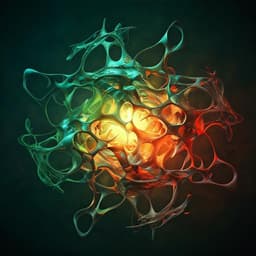
Engineering and Technology
Storing CO₂ while strengthening concrete by carbonating its cement in suspension
X. Fu, A. Guerini, et al.
This innovative study conducted by Xiaoxu Fu, Alexandre Guerini, Davide Zampini, and Alessandro F. Rotta Loria investigates a groundbreaking method for concrete manufacturing that uses CO₂ injection to enhance carbonation efficiency and reduce environmental impact. With a CO₂ sequestration efficiency of up to 45%, this approach not only strengthens concrete but also paves the way for sustainable industrial practices.
~3 min • Beginner • English
Introduction
The study addresses the challenge of reducing CO₂ emissions from cement and concrete, sectors responsible for ~8% of global anthropogenic CO₂. Conventional carbonation methods for concrete—either hardened or fresh—suffer from diffusion-limited kinetics, low capture efficiencies, high energy use, and potential strength loss, limiting their practical benefits and scalability. The research proposes a different fresh-concrete strategy: injecting CO₂ into a diluted cement suspension prior to making paste and concrete. This aims to transform carbonation into a rapid aqueous ionic process, increase capture efficiency, reduce energy intensity, control CaCO₃ polymorphs, and maintain or improve mechanical performance, thereby improving the carbon footprint and enabling industrial implementation.
Literature Review
Past efforts have targeted emission reductions across the cement-concrete lifecycle. Two carbonation categories exist: hardened and fresh concrete. Hardened carbonation (since the 1970s) is diffusion-controlled, typically limited to millimeter penetration, often requiring 1–5 atm vessels, achieving 5–20% uptake with significant energy and infrastructure and mostly suited for precast. Fresh concrete carbonation injects CO₂ during mixing, enabling larger treated volume and simpler industrial integration. Despite commercial pilots, mechanistic understanding remains limited, capture efficiencies are often ≤10%, and energy for pumping, purification, transport, and pressure vessels can offset sequestration gains. Prior work often assumes calcite formation without discussing polymorphs; evidence suggests mixed calcite/aragonite precipitates.
Methodology
Experimental program with four sets: (1) carbonating cement suspensions; (2) adding additional cement to carbonated suspensions to form pastes; (3) adding further cement and aggregates to produce concrete; (4) varying CO₂ flow rates while keeping total injected volume constant to study kinetics and polymorph effects.
Materials and preparation: In a 150 mL beaker, 100 mL deionized water (18.2 MΩ·cm) was stirred; CO₂ (99.9%) was bubbled at 200 sccm for 20 min to saturate. Then 50 g Type I Portland cement (CEM I 42.5R) were added to form a suspension (w/c=2). CO₂ was injected into the suspension for 10, 20, or 40 min (2000, 4000, 8000 scc total at 200 sccm). Set 1 samples (suspensions) were dried in a CO₂-free desiccator (0% RH, ~22 °C, 24 h) and pulverized. For Set 2, an additional 50 g cement was added (stirred 10 min) to obtain paste (w/c=1) and similarly characterized. For Set 3, additional cement was added to reach w/c=0.5, and natural rounded quartz sands and gravels were mixed per the concrete mix design (per m³: cement 500 kg, water 250 kg, aggregates 213 kg (0.06–0.3 mm), 390 kg (0.3–0.9 mm), 294 kg (1–1.7 mm), 280 kg (2–3.2 mm), 388 kg (3–5.6 mm)). Cylinders 33 mm diameter × 67 mm height were cast, demolded after 24 h (100% RH, no CO₂), then cured at 100% RH for 3, 7, 28, and 56 days (n=10 per condition) and tested in compression (ASTM C39, displacement rate 0.18 mm/min; sulfur caps). Reference uncarbonated controls followed the same protocol without CO₂ injection.
Flow-rate study (Set 4): Total CO₂ volume fixed at 8000 scc; flow rates of 100, 200, 400 sccm were applied for 80, 40, and 10 min, respectively, to probe temperature evolution, polymorphs, and strength outcomes (n values provided: temperature n=3; strength n=5).
Characterization: pH and temperature monitored with a Thermo Scientific Elite pocket tester, recording instantaneous and equalized (stirred 10 min) pH. SEM/EDS: JEOL JSM-7900FLV. XRD: STOE-STADI-P (CuKα1, λ=1.54056 Å; 40 kV, 40 mA; 2θ=5–70°, 45 min per sample); phases via Rietveld (GSAS-II) with ICSD references (aragonite, portlandite, calcite, belite, C–S–H, ettringite, alite). TGA/DTA: Netzsch STA under N₂, ~20 mg, RT→1000 °C at 10 °C/min; CO₂ loss quantified from 500–900 °C; capture efficiency and carbonation degree computed by: η = (CO₂ loss treated − CO₂ loss untreated)/CO₂ injected × 100; ε = (CO₂ loss treated − CO₂ loss untreated)/theoretical CO₂ uptake × 100. Theoretical capacity based on representative Type I cement composition (CaO-equivalent stoichiometry).
LCA: Cradle-to-Gate based on CEMEX EPD (EN 15804, ISO 14025), functional unit 1 ton cement. Assumptions include 40% fuel vs 60% calcination emissions; flue gas with 21.76% CO₂ as source; 25% of cement carbonated (as in lab); tap water; CO₂ injection energy via commercial air pumps (200 W each), grid factor 0.39 kg CO₂-eq/kWh; same downstream concrete use; reference injection of 8000 scc per 50 g cement with 26.2% capture efficiency; continuous mixing counted within conventional mixing.
Key Findings
- Injection into cement suspension converts carbonation to rapid aqueous ionic reactions, accelerating CaCO₃ precipitation compared to diffusion-limited hardened/fresh concrete methods.
- SEM/EDS/XRD confirm CaCO₃ crystal formation (calcite and aragonite) on cement particle surfaces; needle-like crystals in carbonated suspensions; in pastes derived from carbonated suspensions, needles at lower CO₂ volumes (2000–4000 scc) and flakes at higher volume (8000 scc). EDS major elements: O 45.1–45.6%, Ca 33.0–34.3%, C 13.1–13.8%, Si 3.0–3.5%, Fe 1.5–1.7%.
- TGA/DTA: increasing injected CO₂ decreases dehydration peak and increases decarbonation peak; decarbonation peaks shift to higher temperatures with more CO₂: 656 °C (uncarbonated), 668 °C (2000 scc), 678 °C (4000 scc), 702 °C (8000 scc), indicating increased crystallinity and polymorph evolution.
- pH/temperature dynamics during suspension treatment: initial DI water pH ~7 at 21.2 °C; CO₂-saturated water pH ~5.3; adding cement raises pH to 12.60 ± 0.05 and temperature to 23.1 °C; CO₂ injection drops instantaneous pH to 12.18 ± 0.08 then stabilizes near 12.6; temperature rises rapidly, stabilizing ~39.5 °C after ~30 min.
- CO₂ capture performance vs injection duration: capture efficiency decreases with duration: 45.4% at 10 min (2000 scc), 26.2% at 40 min (8000 scc). Carbonation degree increases with injected CO₂, up to 17.2% at 40 min (from 3.3% baseline). Captured CO₂ mass per unit concrete volume increases with duration: 5.2, 7.7, and 12.0 kg/m³ for 10, 20, and 40 min, respectively.
- Mechanical performance: at 3 days, carbonated concrete strength is ≥10% higher than uncarbonated. At 7, 28, 56 days, strength depends on injected CO₂ volume: for 2000–4000 scc, strengths can be up to 20.7% lower than uncarbonated; for 8000 scc, strengths are generally higher (up to 23.1%), though differences may not be statistically significant—indicating no compromise in strength at 8000 scc. Uncarbonated reference strengths: 22.9 ± 4.0, 31.0 ± 2.5, 35.4 ± 2.7, 36.5 ± 4.8 MPa at 3, 7, 28, 56 days.
- Flow-rate study (total 8000 scc): all flow rates (100, 200, 400 sccm) yield higher strengths than uncarbonated; 200 sccm produces the highest strengths at all curing ages. Temperature evolution depends on flow; the highest suspension temperature at the time 8000 scc is reached occurs at 200 sccm. SEM shows both needles and flakes at 200 sccm; only needles at 100 and 400 sccm.
- Kinetics and rate-limiting step: Ca(OH)₂ dissolution governs rate; pH drop from 12.60 to 12.18 reduces [OH⁻] from 0.040 to 0.016 M, slowing CO₂ dissolution to CO₃²⁻; agitation minimizes diffusion limits.
- Theoretical capacity: For typical Type I cement (CaO 61.23%), 50 g cement contains ~30.6 g CaO, enabling theoretical capture of ~12,200 scc (~24 g) CO₂ if fully reacted; experimentally, 2992 scc captured at 8000 scc injected due to surface passivation by CaCO₃ and limited residence time.
- LCA: Cradle-to-Gate global warming potential decreases from 519 to 500.3 kg CO₂-eq per ton cement using the proposed approach (−18.7 kg CO₂-eq/t). Extrapolated to global cement production yields ~82.28 Mt CO₂ reduction, with further improvements expected from higher capture efficiencies, looping, and higher carbonated fractions.
Discussion
Injecting CO₂ into a dilute cement suspension leverages aqueous-phase kinetics to overcome diffusion constraints, enabling higher capture efficiencies and polymorph control while reducing energy compared to pressurized or gas-solid treatments of fresh/hardened concrete. Temperature rises during exothermic carbonation/hydration promote aragonite-to-calcite transition and higher crystallinity, stabilizing CaCO₃ and reducing deleterious volume-change-induced cracking. Early-age strength gains stem from nucleation effects and accelerated hydration; at later ages, strength depends on achieving sufficient stable calcite content to avoid polymorph transitions—met at higher CO₂ doses (e.g., 8000 scc) and optimal flow (200 sccm). Kinetic analysis identifies Ca(OH)₂ dissolution as the rate-limiting step; the observed pH decrease corroborates the slowdown in CO₂ capture rate over time. The approach’s practicality is bolstered by simple equipment (no pressure vessels), lower viscosity media, and compatibility with existing mixing processes. LCA indicates a net reduction in carbon footprint even under conservative assumptions, with clear avenues to further improve capture efficiency (longer retention, looping systems, scaling mixers) and potentially utilize treated wastewater. Overall, the findings support the research hypothesis that suspension carbonation can store CO₂ effectively while maintaining concrete strength and reducing process energy and emissions.
Conclusion
The study introduces and validates a suspension-based carbonation approach in which CO₂ is injected into a cement-water suspension prior to paste and concrete formation. Laboratory experiments demonstrate: (1) active CO₂ uptake with capture efficiencies up to 45.4% (10 min) and 26.2% at higher doses (40 min), (2) controlled CaCO₃ polymorph formation (calcite/aragonite) with increased crystallinity at higher CO₂ and optimal flow, and (3) concrete with uncompromised—and often improved—strength, particularly at higher injected volumes (8000 scc) and 200 sccm flow. Mechanistic analyses identify Ca(OH)₂ dissolution as rate-limiting and temperature-driven polymorph transitions as central to strength outcomes. A conservative Cradle-to-Gate LCA shows a 18.7 kg CO₂-eq reduction per ton of cement, with scalability and process enhancements likely to yield larger benefits. Future research should focus on pilot-scale continuous mixers with gas recirculation/looping to increase CO₂ residence time and capture efficiency, optimization of CO₂ dosing and flow to tailor polymorphs and crystallinity, integration with treated wastewater carbonation, and comprehensive durability assessments under field conditions.
Limitations
Experiments were conducted at lab scale using uncapped beakers without CO₂ recirculation, allowing gas losses and limiting residence time; capture efficiencies likely underestimate optimized industrial systems. Only a fraction (25%) of cement was carbonated in the LCA to mirror lab conditions; larger fractions may alter kinetics and mechanical outcomes. Deionized water was used for experimental control (though tap water was used for LCA), which may differ from field conditions. Strength improvements at later ages for some conditions (e.g., 8000 scc) may not be statistically significant given observed variability. Theoretical capacity was not reached due to surface passivation by CaCO₃ and limited treatment time. Sample geometry and curing were controlled (small cylinders, 100% RH, CO₂-free conditions initially), which may not capture all field variability. Long-term durability beyond 56 days and other performance metrics (e.g., permeability, freeze-thaw, reinforcement corrosion) were not comprehensively evaluated.
Related Publications
Explore these studies to deepen your understanding of the subject.







